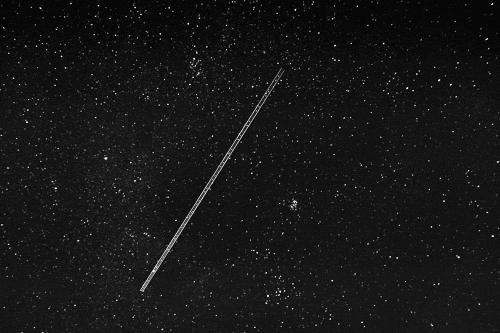Was Earth Born With Life On It?










Was Earth Born With Life On It?
“By finding graphite deposits in zircons that are 4.1 billion years old, graphite deposits that show this carbon-12 enhancement, we now have evidence that life on Earth goes back at least 90% of Earth’s history, and possibly even longer! After all, finding the remnants of organic matter in a certain location means the organic matter is at least as old as the location it’s buried in, but it could still be even older. This is so early that it might make you think that perhaps this life didn’t originate here on Earth, but that Earth was born with life. And this could really, truly be the case.”
How old is life on Earth? If all you had to go on was the fossil record, you’d run into severe trouble once you went back more than one or two billion years, as all your rock would have metamorphosed, making examination and identification of fossils impossible. But recently, we’ve discovered another method: to measure the isotopic content of carbon deposits in ancient rock formations. The carbon-12 to carbon-13 ratio is a surefire signature of life, and tells us that life on Earth goes back at least 4.1 billion years: 90% of the age of our planet. Could this be the hint we’ve needed to conclude that life on Earth actually predates the Earth itself? It’s not quite certain, but the beauty of science is we can always test it and find out! Here’s how.
More Posts from Monstrous-mind and Others
Astronomy From 45,000 Feet
What is the Stratospheric Observatory for Infrared Astronomy, or SOFIA, up to?

SOFIA, the Stratospheric Observatory for Infrared Astronomy, as our flying telescope is called, is a Boeing 747SP aircraft that carries a 2.5-meter telescope to altitudes as high as 45,000 feet. Researchers use SOFIA to study the solar system and beyond using infrared light. This type of light does not reach the ground, but does reach the altitudes where SOFIA flies.

Recently, we used SOFIA to study water on Venus, hoping to learn more about how that planet lost its oceans. Our researchers used a powerful instrument on SOFIA, called a spectrograph, to detect water in its normal form and “heavy water,” which has an extra neutron. The heavy water takes longer to evaporate and builds up over time. By measuring how much heavy water is on Venus’ surface now, our team will be able to estimate how much water Venus had when the planet formed.

We are also using SOFIA to create a detailed map of the Whirlpool Galaxy by making multiple observations of the galaxy. This map will help us understand how stars form from clouds in that galaxy. In particular, it will help us to know if the spiral arms in the galaxy trigger clouds to collapse into stars, or if the arms just show up where stars have already formed.

We can also use SOFIA to study methane on Mars. The Curiosity rover has detected methane on the surface of Mars. But the total amount of methane on Mars is unknown and evidence so far indicates that its levels change significantly over time and location. We are using SOFIA to search for evidence of this gas by mapping the Red Planet with an instrument specially tuned to sniff out methane.

The plumes, illustrated in the artist’s concept above, were previously seen in images as extensions from the edge of the moon. Next our team will use SOFIA to study Jupiter’s icy moon Europa, searching for evidence of possible water plumes detected by the Hubble Space Telescope. The plumes were previously seen in images as extensions from the edge of the moon. Using SOFIA, we will search for water and determine if the plumes are eruptions of water from the surface. If the plumes are coming from the surface, they may be erupting through cracks in the ice that covers Europa’s oceans. Members of our SOFIA team recently discussed studying Europa on the NASA in Silicon Valley Podcast.

This is the view of Jupiter and its moons taken with SOFIA’s visible light guide camera that is used to position the telescope.
🔭🌃🌌

🍂🍁

😮💨📖📚📘📙📗

kitchen ghosts
🍁🍂🎃🍂🍁

Autumn Alley, Germany …..by Michael Boehmlaend
#Cool
What’s Enceladus?
Before we tell you about Enceladus, let’s first talk about our Cassini spacecraft…
Our Cassini mission to Saturn is one of the most ambitious efforts in planetary space exploration ever mounted. Cassini is a sophisticated robotic spacecraft orbiting the ringed planet and studying the Saturnian system in detail.

Cassini completed its initial four-year mission to explore the Saturn System in June 2008. It has also completed its first mission extension in September 2010. Now, the health spacecraft is making exciting new discoveries in a second extension mission!
Enceladus

Enceladus is one of Saturn’s many moons, and is one of the brightest objects in our solar system. This moon is about as wide as Arizona, and displays at least five different types of terrain. The surface is believed to be geologically “young”, possibly less than 100 million years old.
Cassini first discovered continually-erupting fountains of icy material on Enceladus in 2005. Since then, the Saturn moon has become one of the most promising places in the solar system to search for present-day habitable environments.

Scientists found that hydrothermal activity may be occurring on the seafloor of the moon’s underground ocean. In September, it was announced that its ocean –previously thought to only be a regional sea – was global!
Since Cassini is nearing the end of its mission, we are able to make a series of three close encounters with Enceladus, one of Saturn’s moons.
Close Encounters
On Oct. 14, Cassini performed a mid-range flyby of Enceladus, but the main event will take place on Oct. 28, when Cassini will come dizzyingly close to the icy moon. During this flyby, the spacecraft will pass a mere 30 miles above the moon’s south polar region!

This will be the deepest-ever dive through the moon’s plume of icy spray, where Cassini can collect images and valuable data about what’s going on beneath the frozen surface.
Make sure to follow us on Tumblr for your regular dose of space: http://nasa.tumblr.com
🔭🌌🍂🍁

Stars and Dust in Corona Australis (NASA)

You never forget your first true love...

cozy autumn days

-
 monstrous-mind reblogged this · 4 years ago
monstrous-mind reblogged this · 4 years ago -
 monstrous-mind liked this · 4 years ago
monstrous-mind liked this · 4 years ago -
 aceang liked this · 6 years ago
aceang liked this · 6 years ago -
 heyfromdno liked this · 6 years ago
heyfromdno liked this · 6 years ago -
 jowlzmasud-blog liked this · 7 years ago
jowlzmasud-blog liked this · 7 years ago -
 calicoskatts liked this · 7 years ago
calicoskatts liked this · 7 years ago -
 madridgirl7 reblogged this · 7 years ago
madridgirl7 reblogged this · 7 years ago -
 sponfawn liked this · 8 years ago
sponfawn liked this · 8 years ago -
 absurdistocchiolism reblogged this · 8 years ago
absurdistocchiolism reblogged this · 8 years ago -
 absurdistocchiolism liked this · 8 years ago
absurdistocchiolism liked this · 8 years ago -
 nuderefsarebest reblogged this · 8 years ago
nuderefsarebest reblogged this · 8 years ago -
 drhoz liked this · 8 years ago
drhoz liked this · 8 years ago -
 nautilis17 reblogged this · 8 years ago
nautilis17 reblogged this · 8 years ago -
 oldmaninaz liked this · 8 years ago
oldmaninaz liked this · 8 years ago -
 prince-tips reblogged this · 8 years ago
prince-tips reblogged this · 8 years ago -
 prince-tips liked this · 8 years ago
prince-tips liked this · 8 years ago -
 frostythelawfullchaotic liked this · 8 years ago
frostythelawfullchaotic liked this · 8 years ago -
 noble-ghostly-prince reblogged this · 8 years ago
noble-ghostly-prince reblogged this · 8 years ago -
 spacetimewithstuartgary reblogged this · 8 years ago
spacetimewithstuartgary reblogged this · 8 years ago -
 airglo90-blog liked this · 8 years ago
airglo90-blog liked this · 8 years ago -
 rejectedbellybuttonpiercing reblogged this · 8 years ago
rejectedbellybuttonpiercing reblogged this · 8 years ago -
 dare-mightythings liked this · 8 years ago
dare-mightythings liked this · 8 years ago -
 nuderefsarebest liked this · 8 years ago
nuderefsarebest liked this · 8 years ago -
 imnotafraidofdyinyoung reblogged this · 8 years ago
imnotafraidofdyinyoung reblogged this · 8 years ago -
 kaldary reblogged this · 8 years ago
kaldary reblogged this · 8 years ago -
 raycherd liked this · 8 years ago
raycherd liked this · 8 years ago -
 cutemairmade liked this · 8 years ago
cutemairmade liked this · 8 years ago -
 shaniaxxx-blog1 liked this · 8 years ago
shaniaxxx-blog1 liked this · 8 years ago -
 sweetxscape liked this · 8 years ago
sweetxscape liked this · 8 years ago -
 whattheworldisreallylike-blog reblogged this · 8 years ago
whattheworldisreallylike-blog reblogged this · 8 years ago -
 kaldary liked this · 8 years ago
kaldary liked this · 8 years ago -
 iiixgreedxiii liked this · 8 years ago
iiixgreedxiii liked this · 8 years ago -
 josuemunoz liked this · 8 years ago
josuemunoz liked this · 8 years ago -
 mrfloydian liked this · 8 years ago
mrfloydian liked this · 8 years ago -
 asongwithnoend liked this · 8 years ago
asongwithnoend liked this · 8 years ago -
 mysassytigerus liked this · 8 years ago
mysassytigerus liked this · 8 years ago -
 photonic-pulsar liked this · 8 years ago
photonic-pulsar liked this · 8 years ago -
 mys-thoughts reblogged this · 8 years ago
mys-thoughts reblogged this · 8 years ago -
 mys-thoughts liked this · 8 years ago
mys-thoughts liked this · 8 years ago
My ambition is handicapped by laziness. -C. Bukowski Me gustan las personas desesperadas con mentes rotas y destinos rotos. Están llenos de sorpresas y explosiones. -C. Bukowski. I love cats. Born in the early 80's, raised in the 90's. I like Nature, Autumn, books, landscapes, cold days, cloudy Windy days, space, Science, Paleontology, Biology, Astronomy, History, Social Sciences, Drawing, spending the night watching at the stars, Rick & Morty. I'm a lazy ass.
222 posts